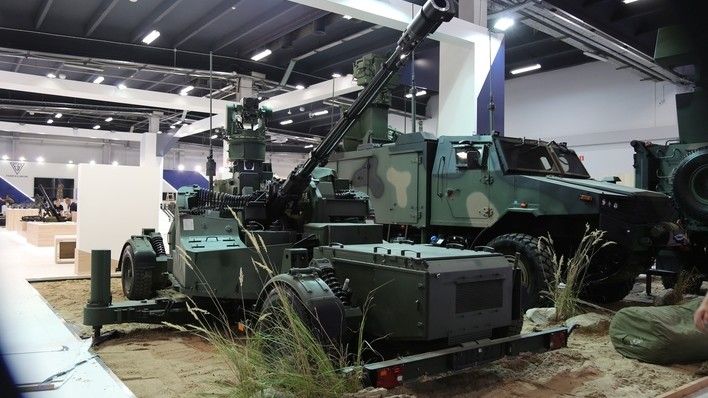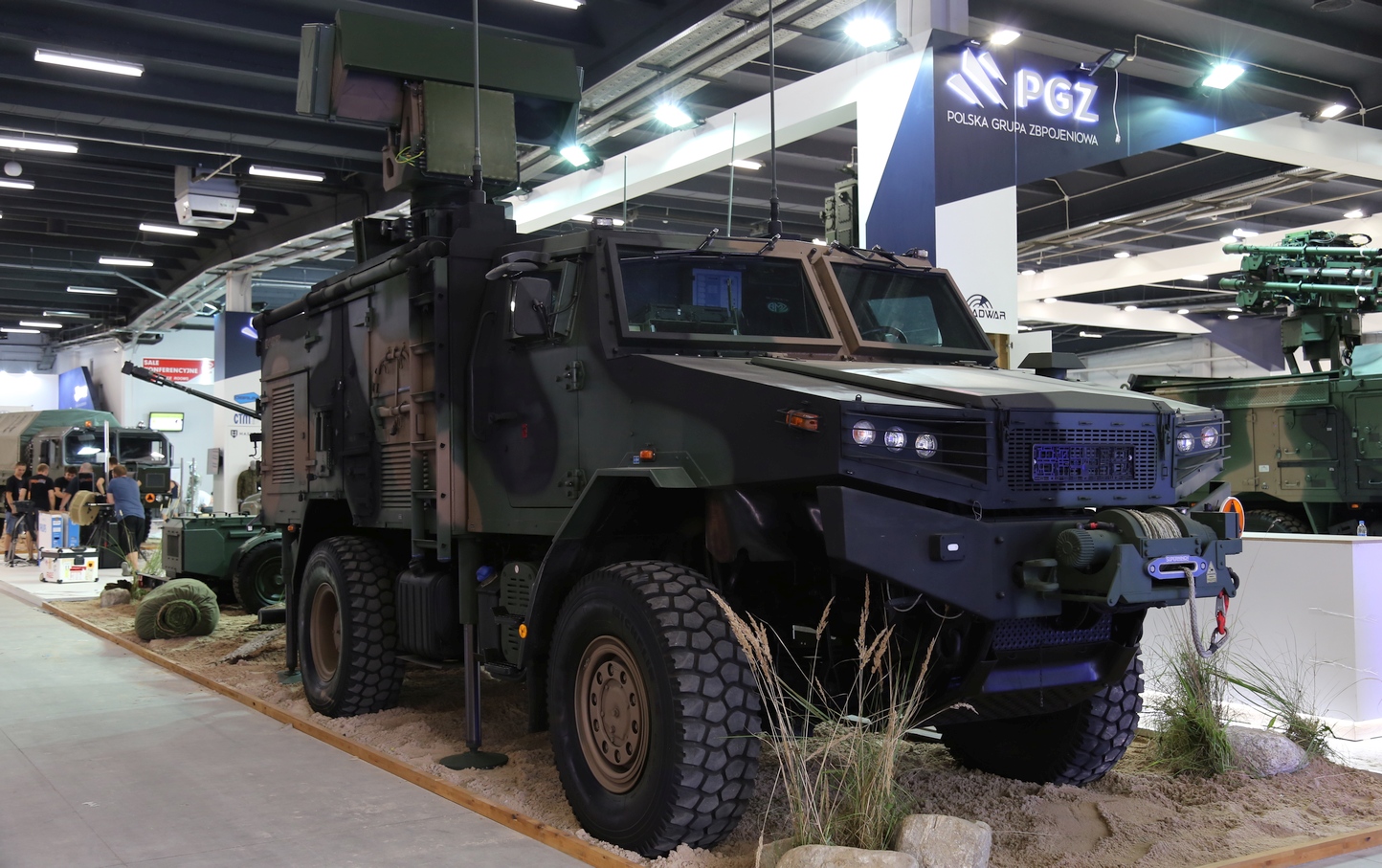Polish 35 mm Cannon Passes the Test Programme. Programmable Ammunition Comes Next

The 35 mm AG-35 anti-aircraft gun developed by PIT-RADWAR went through a number of tests last year. Further testing is expected to happen this year, and within the framework of the planned trials the ability to shoot programmable rounds is going to be verified too. The weapon is being demonstrated during this year’s edition of the MSPO event.
AG-35 cannon coupled with an optronic sensor is to become a cornerstone of the Noteć programme that is to lead towards selection of a replacement of the S-60M cannons used by the coastal units of the Polish Navy. The project in question is currently at the stage of technical dialogue. 35 mm cannons may also be used for other purposes. The mobile variant, installed on a wheeled or tracked platform, along with the self-propelled Poprad SAM systems, could provide air defence capabilities for the land forces units on the move, within the scope of the very short range (VSHORAD) level of the IADS.
Czytaj też: Future of the Polish Radar Technologies [REPORT]
AG-35 cannon has been designed to act against a variety of threats, including aircraft, helicopters, cruise missiles or UAVs, at a distance of up to 5.5 kilometres and flying at altitude of up to 3.5 kilometres. Maximum threat speed has been defined as 600 metres per second.
Tests concerning the individual components of a battery prototype took place in the late 2017. Accuracy of the cannons was verified in March, August and September, and tests were also conducted with regards to a communications system that would make it possible to couple the cannon with the Bystra radar. The tests also covered transfer of the radar data to the battery. The procedures were performed, for instance, during the Dragon 2017 exercise.

Programmable rounds designed for this system were the only relevant element omitted during the test programme last year. However, ammunition of this kind is being tested by PIT-RADWAR in parallel with the remaining battery components. According to the manufacturer, a complete anti-aircraft battery is to be tested between October and November 2018. The testing is to involve the aforesaid programmable rounds as well. The work is to be finalized by the end of this year, according to the plans made.
Read more: Poprad SHORAD Delivered to the Polish Army
The programmable rounds are to be useful in acting against smaller targets, such as UAVs or precision munitions. Meanwhile, sabot rounds are better suited for long distance engagements against targets travelling at high velocities. This is possible thanks to the better ballistic properties of the rounds as such, including parameters such as higher velocity and lower weight of the projectiles.

AG-35 cannons enjoy interest among the potential foreign customers, including the Indian military which is very much interested in the programmable rounds. However, the main goal of the project is to prepare a product for the Polish Armed Forces.
PIT-RADWAR is already involved in the “Noteć” project, within the framework of a consortium led by the PGZ Group. This means that not only is the gun being showcased, as the manufacturer also presents an idea for a whole air defence battery unit. When it comes to the weapons, the company is focused on the AG-35 cannon featuring an optronic tracking sensor. The A-35 variant is designed with coupling with a sensor-platform in mind. Thus it is somewhat placed in the shadows of the gun’s big brother using its own optronic system, when it comes to autonomous detection, interception and neutralization of threats.

PIT-RADWAR acts as the main integrator of the anti-aircraft battery system featuring the 35 mm cannon. The company works together with HSW S.A., delivering the KDA automatic weapons, and ZM Tarnów - responsible for delivering the KDA gun control system, ammunition feed and loading system.
When it comes to the cannon itself, the control subsystem also allows the user to change the ammunition type, as two magazines are used to feed the gun with rounds, placed on the opposite sides of the cannon. This makes it possible to use two types of ammunition (FAPDS-T and ABM rounds at the same time), which means that the gun has an ability to act against a variety of airborne threat and also offers a function of to immediately changing the type of rounds used in engagement.

The cannon may work in a variety of modes: automatic, semi-automatic and autonomous. In the automatic mode no operator is required to work on the gun. In the semi-automatic setting the operator operates the cannon, but he is only required to pull the trigger, when ordered to do so by the fire control vehicle crew. In the autonomous mode the gun is operated solely by the operator who uses the system’s fire control solution including an optronic sensor with a HF laser rangefinder and automatic target tracking system using optoelectronic sensors.
In the automatic and semi-automatic modes the cannon, using the datalink, remains in contact with the command level placed above it - the WG-35 fire control vehicle. When configured in this way the cannon receives firing solutions from the command platform, created on the basis of data provided by the WG-35 optoelectronic system.

In the autonomous mode, data provided by the cannon’s own optoelectronic sensor is used to create the firing solutions and carry out ballistic computations. The optronic sensor intercepts the target on the basis of the data provided by the fire-control vehicle or command vehicle. Once automatic tracking is engaged and range is measured, a firing solution is developed. Configuration as such does not exclude independent target searching through observation and scanning of the airspace with the use of own sensor.
As the fire control vehicle uses its own optoelectronic system it may also attack the selected threat with the use of cannons operated in automatic and semi-automatic mode. The battery commander may assign targets to the remaining targeting channels available in case of the cannons forming the battery and fitted with own optronic sensors. Thanks to a high number of sensors, multiple target tracking channels are available. The battery commander may assign multiple fire units to a single threat, enhancing the effectiveness of the system.
Ultimately the target assignment process should be taken over by the command vehicle gathering the radar data, processing it and sending it to the individual cannons of the battery. However, no command vehicle is being developed in case of the 35 mm anti-anti aircraft battery project, while the listed tasks are being accomplished by the fire control platform.
AG-35 tracking sensor features an integrated system of optical sensors and a high repetition rate laser rangefinder. The optical sensors include a TV and a thermal imaging camera. In the future the anti-aircraft battery would need to be equipped with a radar integrated within the optronic sensor of the fire control vehicle.
Both the fire control vehicle, as well as each of the cannons, have been fitted with an INS/GPS navigation unit, making it possible to position the cannon precisely and continuously measure the elevation, azimuth and tilt. The AG-35 cannon can be rapidly deployed on the firing position and it is ready to fire in a short time. Only a few minutes are needed to ready the gun to fire.

KDA 35 mm automatic cannon constitutes the basic building block of the system developed by the PIT-RADWAR S.A company, similarly as in case of the naval variant. The licence for manufacturing the system has been acquired by CNPEP RADWAR, now known as PIT-RADWAR S.A, in Switzerland, back in the year 1995. Then, documentation and hardware has been received by the Huta Stalowa Wola facility, on the basis of a free-of-charge implementation agreement, where the weapon is being manufactured at the moment. KDA 35 offers rate of fire of 550 rounds per minute with a double ammunition feed.
AG-35 is a modern anti-aircraft gun that could potentially support the Polish military in the area of establishing the lowest level of the IADS, acting as the direct defensive means for the mobile objects and units, together with the Poprad system. The equipment also has a certain modernization potential. A project has been launched to develop a battery command vehicle or to integrate the cannon with a tracking radar.